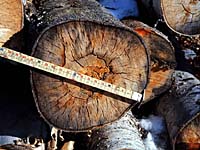

Trees can tell us a great deal about their location and history if interpreted properly. Foresters study tree cross-sections or discs in order to learn about the life histories of individual trees and to ascertain the history of the surrounding area (for example, the last fire in the area could be marked by a fire scar, the last drought by a very narrow growth ring). The study and interpretation of tree discs in this manner is referred to as dendrochronology. |
Remember that trees form new wood in the spring and summer only. Spring wood is lighter in colour than summer wood. This growth shows up in a series of light (spring growth) and dark (summer growth) rings called annual rings.
The new layer of wood produced by a tree each year is an active part of the life of the tree, conducting sap and storing reserve food. As time passes and new layers are added to the outside of the tree, the older wood cells in the centre become inactive and stop transporting water and nutrients. The inactive wood cells build up deposits of various kinds of chemicals, which change their colour and cause them to show up as dark coloured heartwood.
Different kinds of trees build up different kinds and amounts of chemicals in the heartwood. This explains why not all trees show the same kind of development. Spruce and balsam fir have small amounts of chemical deposit in the heartwood, so it appears virtually the same as the sapwood. Some of the chemicals in the heartwood of white oak and cedar are toxic to certain fungi, making this wood very decay resistant.
Because spring growth is generally faster than summer growth, the light rings are usually wider.
One light ring together with the adjacent darker outer ring represent one year's growth.
Growth rings vary in size according to each year's growing
season. Their size is influenced by environmental conditions such
as weather, amount of growing space, soil condition, insect attacks,
and fire.